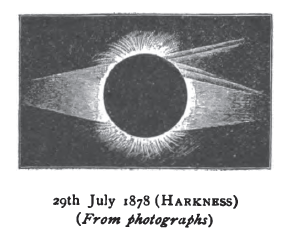| Total eclipse | |
| Gamma | 0.6232 |
|---|---|
| Magnitude | 1.045 |
| Maximum eclipse | |
| Duration | 191 s (3 min 11 s) |
| Coordinates | 53°48′N124°00′W / 53.8°N 124°W |
| Max. width of band | 191 km (119 mi) |
| Times (UTC) | |
| Greatest eclipse | 21:47:18 |
| References | |
| Saros | 124 (47 of 73) |
| Catalog # (SE5000) | 9230 |
A total solar eclipse occurred at the Moon's descending node of orbit between Monday, July 29, and Tuesday, July 30, 1878, with a magnitude of 1.0450. A solar eclipse occurs when the Moon passes between Earth and the Sun, thereby totally or partly obscuring the image of the Sun for a viewer on Earth. A total solar eclipse occurs when the Moon's apparent diameter is larger than the Sun's, blocking all direct sunlight, turning day into darkness. Totality occurs in a narrow path across Earth's surface, with the partial solar eclipse visible over a surrounding region thousands of kilometres wide. Occurring about 2.4 days before perigee (on August 1, 1878, at 6:45 UTC), the Moon's apparent diameter was larger. [1]
Contents
- High-altitude astronomy
- Eclipse images
- Eclipse details
- Eclipse season
- Related eclipses
- Eclipses in 1878
- Metonic
- Tzolkinex
- Half-Saros
- Tritos
- Solar Saros 124
- Inex
- Triad
- Solar eclipses of 1877–1880
- Saros 124
- Metonic series
- Tritos series
- Inex series
- References
- Further reading
- External links
The path of totality was visible from parts of modern-day eastern Russia, Alaska, western Canada, Washington, Idaho, Montana, Wyoming, Colorado, New Mexico, Kansas, Oklahoma, Texas, Louisiana, Cuba, Haiti, and the Dominican Republic. A partial solar eclipse was also visible for parts of Northeast Asia, North America, Central America, the Caribbean, and northern South America.
Newspapers in the United States reported of large migrations from the Midwest towards the path of totality to view the eclipse. Scientists observing from Pikes Peak in Colorado contended with altitude sickness and snowstorms, among other problems. [2] [3]












































































































